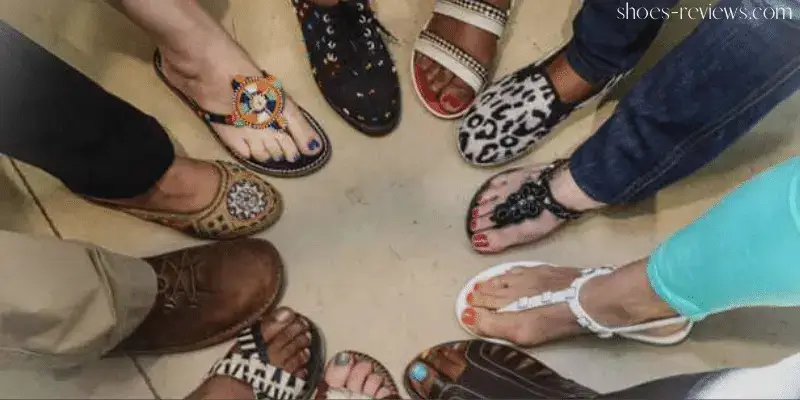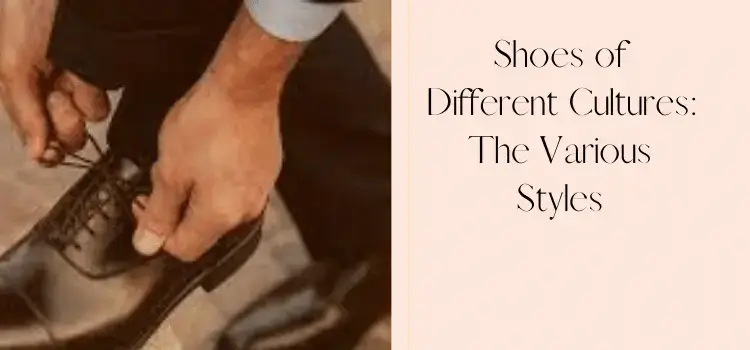
Step into a world where shoes tell stories. Bridge gaps between generations and showcase the diversity of cultures across the globe. From vibrant handcrafted sandals to elegant wooden clogs, every pair has its tale to tell.
As we know, shoes in different cultures? The simple answer is Shoes in different cultures have their own stories, which is why they tell us so much about the culture.
So, please put on your best pair and walk together through the magical stories. Woven into shoes from different countries!
Historical Background Of Shoes As A Cultural Symbol
Shoes are cultural symbols. They are signs of status in many cultures. In some countries, shoes are a sign of strength and power.
Most shoes in ancient Egypt were made of gold or silver. They meant wealth and power. The Greeks wore shoes made of leather. They stood for courage. Rome made shoes out of iron. They were a sign of strength.
Shoes can also be too tight. In the Middle Ages, European women had to wear thick, difficult shoes that made it hard for them to run away or work well. China tied the feet of women to make them stay small. It was called tying the feet.
Shoes still have a place in culture. They can show how you dress. They are also political. Many Americans wear sneakers or flip-flops because dressing and acting is acceptable.
Shoes In Different Cultures
There have been a lot of stories about shoes. The Box of Pandora is one. When Pandora’s box was opened, all the world’s sins were shown. Shoes were in the box. People thought that these shoes would bring bad luck. History changed the way Greeks made shoes. Another famous shoe story is “The Emperor’s New Clothes.
” An emperor is tricked into wearing clothes that can’t be seen. e is too proud to say he can’t see dresses and only wears shoes out in public. His story changed the way that people think about pride and greed.
Shoe styles change around the world. Some societies have to wear shoes. Sometimes they show their manners. n different places, shoes are:
Most Americans wear shoes every day. Shoes are also made with fashion in mind. You can wear sneakers and dress shoes somewhere else. Europe needs shoes, too, but less for dresses. Regarding shoes, comfort, and usefulness are sometimes more important than style. In Germany, utility is usually more important than looks.
Different Asians wear different shoes for other events. Outside, people in China wear shoes or flip-flops. Japanese kimono users use wooden geta shoes. South Koreans wear plastic flip-flops called jjokbong as their everyday shoes.
Around the world, shoe culture is different. The next time you put on shoes, think about what they mean and what they remind you of.
Traditional Footwear In Europe
In Europe, people wear many different kinds of classic shoes. In some countries, like Italy and Spain, sandals and shoes with open toes are common. In other places, like England and Scotland, it isn’t. People wear shoes with closed toes, like Oxfords or flats.
In Europe, people also wear many different kinds of classic boots. Some countries, like Germany and Austria, have a lot of snow. Lederhosen is knee-high boots that people wear. People in other places, like Switzerland and Sweden, wear chukka boots that stop at the ankle.
No matter what kind of traditional shoes you choose. Remember that European shoe sizes are usually smaller than those in the US. Before you buy, try on a few pairs to find the right fit.
Asian Footwear Traditions
Asian traditions about shoes are very interesting. Asians have been making beautiful and unique shoes that reflect their cultures. And ways of life for thousands of years. Asian shoes are very popular right now. Shoppers who know about trends go to Asia. Flats and shoes with Asian designs are easy to find.
Looking for Asian shoes? Learn about these customs:
- Geta are the native shoes of Japan. Geta are wooden clogs made in Japan. Geta made of wood or bamboo has a higher platform for your feet.
- Jika-tabi: This Japanese shoe is worn by building workers and other physical laborers. Work shoes with split toes are easier to hold on to.
- Mary Jane: Mary Jane shoes from China became popular in the West during the Victorian period. Shoes with low heels and ankle straps made of black leather or silk.
Middle Eastern Footwear Traditions
Shoes from the Middle East have a long past. There are hot fields and cold mountains in this area. Over the years, shoes have changed to match this. Sandals from the Middle East are well-known. A strap or band holds on simple shoes like these. In hot weather, they keep their feet cool and let air in.
Middle Easterners also like boots. Dry weather can hurt your feet and knees, but soft leather boots protect them. Traditional clothes have a lot of needlework or beads on them.
Mountains have also affected the shoes of the Middle East. People there wear djellabas. They can reach and are made of strong leather or cloth. Protection from the cold and rough ground.
African Footwear Traditions
African shoes have been around for a long time. Each place has its style of shoes made from local materials. In the Sahara Desert, shoes made of leather protect the feet. West Africans wear colored cloth shoes with beads on them. Africans show who they are through their shoes.
Shoes offer status, wealth, and faith. Only powerful people or religious leaders wear certain boots. In Ethiopia, “Gabbi” shoes are worn by priests and other church leaders. African shoes are both beautiful and helpful.
Several shoes protect your feet from hot sand and rough ground. Some cool shoes in Africa are both useful and stylish.
North American Footwear Traditions
Native American people in North America have been making and wearing moccasins for a long time. Most moccasins are made of soft leather and have beads and other designs. It’s easy to put them on, and they keep your feet warm when it’s cold outside.
All Native American groups made moccasins in the past. Native Americans can get moccasins from a lot of places. Those who are not Native Americans. Every day, people put on moccasins. Native Americans used to wear shoes as part of their usual clothing.
South American Footwear Traditions
In South America, there are still a lot of traditional cultures that are important to daily life. One of them is that people always wear shoes. n some countries, people only wear shoes for important events. In other places, they are part of what people wear every day.
South American shoes come in many styles, from simple flats to boots. From the shoes the Incas wore to the Navajos’ feathered moccasins. The background and meaning of each class are different.
In many South American societies, shoes are an important part of how things are done. It’s a way to show respect for others and stay true to your culture.
Global shoe brands show varied cultures.
Global shoe brands reflect diverse cultures. Adidas, a popular German shoe brand, makes good shoes that work well. Nike is an American shoe company with unique patterns. Converse, an American shoe company, is a sign of the United States.
These shoe brands are well-known around the world. Sics, a famous Japanese shoe company, makes durable, comfortable boots. Puma shoes are fast, tough, and good at what they do.
Reebok shoes are a mix of the old and the new. Gucci shoes have a lot of style and class. Timb Rland makes shoes for outdoor use in the United States.
How shoes show a culture

Shoes are important in many cultures and can reflect an individual’s culture. In some places, shoes are social markers and cost a lot. In o her sites, shoes serve a purpose and keep the feet safe.
Shoes have more than one use in every culture. Shoes are seen as a part of the body in many countries. They can be taken off before going into a home or church.
In different cultures, only certain people can wear certain shoes. In others, everyone wears the same shoes. No matter what, a person’s shoes might show their culture.
What’s their shoe reaction? They’re Home
Different cultures like different kinds of shoes. In many places, entering a home barefoot is a sign of respect. Some cultures don’t let people wear shoes. Shoe responses depend on culture. In many places, entering a home barefoot is a sign of respect. You can’t come in with dirty shoes.
In some countries, shoes are used for work. Because shoes are useful, Westerners only take them off when they get home. They get their feet dry. You should take your shoes off When seeing a dignitary or a church. In East Asian houses, shoes must be taken off. They often bring trash and other things inside.
Take off your shoes. Seeing a famous person or going into a building. The boots in South America are made to be worn. They are old inside and out, with no thought of cleanliness.
Technology is Changing Traditional Footwear Worldwide
Technology is changing the way shoes are made. The way shoes are made and sold is changing because of new technologies and businesses. Most shoes were made by hand with simple tools. Costs money and takes time. Hu dreds of pairs of shoes are made by machines every hour.
It made shoes less expensive everywhere. There are different ways to sell shoes. Most shoes were sold at stores with walls and floors. Now, a lot of people buy shoes online. They helped both people and businesses. Shoe use is also changing. Shoes for running and walking were once the usual.
Here are now shoes for hiking, basketball, and CrossFit. t helps people find the right shoe and helps businesses reach more people.
Different places have their favorite shoe styles.
People wear sandals a lot in Africa. Most of the time, they are made of leather and have beads on them. People like a lot of shoe styles from Europe. In Germany, people like to wear clogs. Italy and Spain both wear shoes made of leather.
In the US, people like to wear boots. People also wear sandals, boots, and dress shoes. Asian dress shoes are called geta or zori. These shoes have wooden feet and are worn with socks or Japanese tabi. Chappals are worn in Pakistan and India. The stitching and beads on these open-toed shoes are bright and fun.
In the Middle East, people like to wear leather shoes called babouches. They are made with skill and come in many different colors and patterns.
Throughout History
Shoes have been worn for thousands of years, often showing how people live. The ancient Egyptians wore soft leather shoes to protect their feet. Old Greek men and women wore multi-strap shoes. The Roman Empire made shoes called Caleus high shoes.
Middle Ages shoes were status markers. Skilled shoemakers made shoes for nobles that were covered in jewels. Most wore shoes made of cheap leather.
During the industrial revolution, many cheap shoes were made. Back then, people wore boots and shoes. Shoes come in many styles and sizes these days. Shoes are useful and look good.
Conclusion
This study looked at shoes from many different cultures. Chinese shoes with laces to Japanese boots made of wood. We’ve seen how the shoes of other countries are other. Shoes finish off an outfit; they show style, character, and culture. You can tell much about yourself from your shoes, so don’t be afraid to show them off.